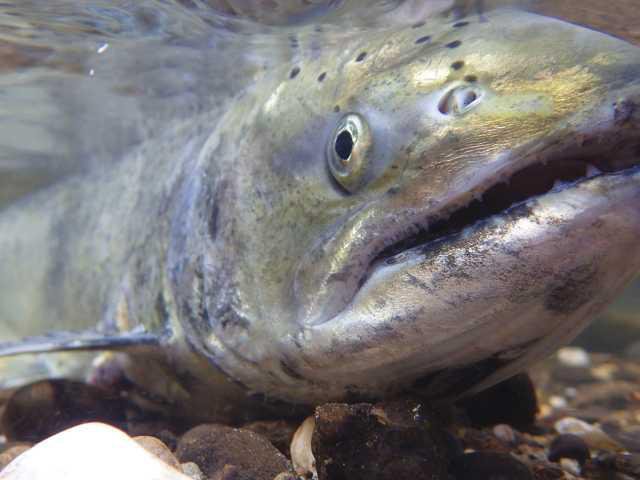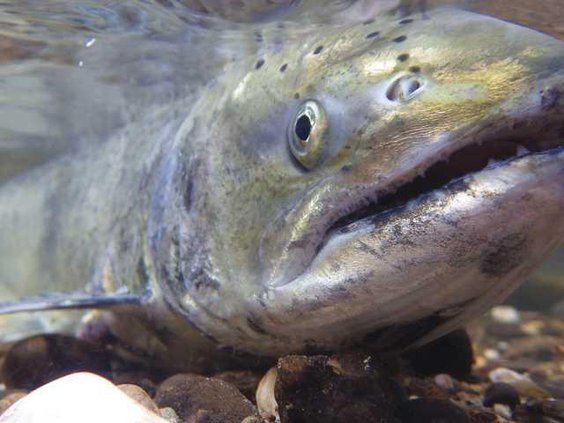A scientific study covering 11 years of fish migration on the Stanislaus River underscores how simply sending more water downstream may not be doing endangered Chinook salmon any favors.
Data shows there is a certain threshold for pulse flow volume that if it is exceeded doesn’t improve fish migration. It also points to other solutions such as the placement of the rock barrier at the head of the Old River west of Mossdale Crossing/Interstate 5 in Lathrop that suggests other water management actions that lift the level of dissolved oxygen and such are critical factors in improving fish migration.
The new study by Fishbio — an environmental consulting company with a team of scientists, engineers, and technicians — was published in the current issue of the North American Journal of Fisheries. It finds that “releasing prescribed volumes of water from reservoirs in pulse flows has had a limited effect on stimulating adult salmon migration in the Central valley’s Stanislaus River.”
The data was gleaned from 2003 through 2014 using a weir to force fish heading upstream to pass through near Riverbank to get a precise account of migrating fish numbers.
The publication of the research comes as the state is pushing a plan to significantly increase water releases for sustained periods of unimpaired flows on the Stanislaus — as well as the Merced and Tuolumne rivers — from February through June. That proposal would consume 360,000 acres of water a year beyond what is now flowing out of reservoirs. It would come at the expense of farm production and jobs that the state concedes would take a major hit in the Northern San Joaquin Valley in exchange for perhaps coaxing what the state estimates is another 200 fish upstream between the three rivers.
While the unimpaired flows the state is pushing is at a different time of the year than when Fishbio did its migration research from October to December, it underscores that simply throwing more water at the problem will do little if anything to improve fish survival rates. It also points to other options that can be done in concert with more precise and shorter pulse flows that more mimic nature that could significantly boost fish survival.
Managed pulse flows have taken place on the Stanislaus River every October since 1992. But until the South San Joaquin Irrigation District and Oakdale Irrigation District stepped up and decided data was needed to make sure the strategy was in the best interest of fish and started funding Fishbio in 2003 to look at ways of improving the river for fish no research had ever been done and that includes both the state and federal governments.
The study looked at managed pulse flows, water temperature, dissolved oxygen and how the initiation of the barrier at the head of the Old River where is splits from the main San Joaquin River channel affected the timing and patterns of adult salmon migration.
They found support that pulse flows stimulated salmon migration in only two of the 11 years studied, and that the response in fish migration was small and short lived, lasting only for a few days. The study also found that flows higher than 700 cubic feet per second (cfs) — water volume the equivalent of 700 basketball pass in a specific point during one second — did not prompt any additional migratory activity, suggesting 700 cfs may be an optimal amount of water to release to achieve a response in salmon movement.
“This study highlights the importance of long term monitoring to understand fish responses to management actions in highly variable environments”, says Doug Demko, Fishbio President. “Research findings such as these don’t come in a year or two.”
Demko also notes pulse flows began as an experimental management action, but were adopted as a regulatory requirement without any scientific
The new study is the first to formally examine the relationship between environmental factors, pulse flows, and Chinook salmon migration on a regulated river in California’s Central Valley. The OID, SSJID, and the Tri-Dam Project provided funding for the long-term salmon monitoring on the Stanislaus River that formed the basis of the study.
Fishbio has a world-wide reputation for its environmental work involving research, monitoring and conservation of fisheries. They have offices in Chico, Oakdale, and Laos.
To contact Dennis Wyatt, email dwyatt@mantecabuletin.com
PULSE FLOWS A BIT FISHY
11-year science study casts doubt on effectiveness of state strategy



